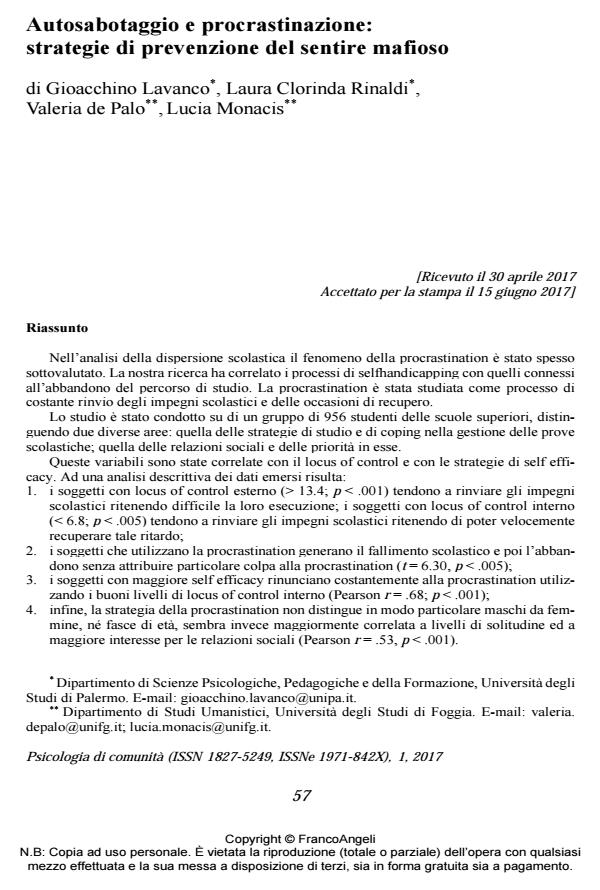Self-handicapping and procrastination: prevention strategies of "mafia feeling"
Journal title PSICOLOGIA DI COMUNITA’
Author/s Gioacchino Lavanco, Laura Clorinda Rinaldi, Valeria de Palo, Lucia Monacis
Publishing Year 2017 Issue 2017/1
Language Italian Pages 21 P. 57-77 File size 257 KB
DOI 10.3280/PSC2017-001006
DOI is like a bar code for intellectual property: to have more infomation
click here
Below, you can see the article first page
If you want to buy this article in PDF format, you can do it, following the instructions to buy download credits

FrancoAngeli is member of Publishers International Linking Association, Inc (PILA), a not-for-profit association which run the CrossRef service enabling links to and from online scholarly content.
In the analysis of early school leaving the procrastination phenomenon has often been underestimated. Our research has linked the selfhandicapping processes with those related to the drop-out of the study program. Procrastination was intended as a process of constant postponement of school commitments and recovery occasions. The study was conducted on a group of 956 high school students, according to two different areas: study strategies and coping in the management of educational tests; social relationships and their priorities. These variables were correlated with locus of control and self-efficacy strategies. A descriptive analysis of the obtained data shows: 1- People with external locus of control (> 13.4; p < .001) tend to postpone the schoolwork considered difficult; those with internal locus of control (< 6.8; p < .005) tend to postpone schoolwork as they feel to firstly counter the deficit; 2 - Individuals who procrastinate are more likely to fail at school and then to abandon it without attributing blame particularly to procrastination (t = 6.30, p < .005); 3 - Individuals with higher self-efficacy do not procrastinate having also higher levels of in-ternal locus of control (Pearson r = .68; p < .001); 4 - Finally, there are no gender and age differences in procrastination strategies, which seem more closely related to levels of loneliness and a greater interest in social relationships (Pearson r = .53, p < .001). With regard to intervention strategies it has been verified that people with supportive peer groups do not tend to procrastinate, whereas more isolated individuals procrastinate in conditions of melancholy and conflict. As procrastination has been found to be a predictor of self-handicapping, more work within the school context should be needed to train teachers in the prevention of school procrastination.
Keywords: Self-handicapping, procrastination, drop-out
Gioacchino Lavanco, Laura Clorinda Rinaldi, Valeria de Palo, Lucia Monacis, Autosabotaggio e procrastinazione: strategie di prevenzione del sentire mafioso in "PSICOLOGIA DI COMUNITA’" 1/2017, pp 57-77, DOI: 10.3280/PSC2017-001006